- Home
- Replacement Artwork,logos,etc Available
- The Allwin Arcade
- Trade Stimulators
- The Strange & Unusual
- The Aristocrat Collection
- The Bally Collection
- The Bell-Fruit collection
- The BDR/BMR Collection
- The Bryans Collection
- The Buckley collection
- Caille Brothers Collection
- Working Models
- The Groetchen collection
- The Hawtin's Collection
- The Jamieson's Collection
- The Jennings collection
- The Mills Collection
- The NSM (Bingen) Collection
- The Oliver Whales Collection
- The Pace Collection
- The Parkers Collection
- The Rock-ola collection(slot machines)
- The Ruffler & Walker Collection
- The SEGA Collection
- the Shefras collection
- The TH.Bergmann Collection
- The Tom Boland collection
- The Watling collection
- The Whittaker Bros Collection
- the Wondermatics collection
- The Wulff Collection
- The Juke Box Age
- Coin Operated Cranes & Diggers
- Coin Operated Shooting Games
- Coin Operated Weight Scales
- slot machine coins & tokens for sale
- Amusement Arcades from the Past
- The British Seaside Pleasure Pier
- The Market Place
- Coin Operated Related Seaside Postcards
- See a Selection of the More Complex Machines at Work
- Stuart Dale's Imperator Rebuild
- Stuart Dale's Steam Shovel Project
- The "Allwin" Machine
- Useful Links
- The Rye Heritage Ctr Collection of Working Models
- Williamson's Vintage amusement arcades
- Contact Us
The Strange & The Unusual

Right form the the beginning coin operated amusement (and Vending) machine makers were producing odd and often improbable machines to entice the public. Perhaps it went back to the old showman's ethos "the public will always pay to see or play something unusual" be it a two headed dog or a machine to test your lungs. Here,in this section, are some of the most unusual, some were very successful, others were not.
Page 1
Lung Testers and Electricity is Life
Lung Testers
These somewhat odd additions to the amusement arcade probably started life as a spin-off from the medical Spirometer, used then (and still today in a healthy modern form) to test the strength of a patients lungs. The first arcade spirometers appeared in the late 19th cent and were a big hit. Often housed in beautifully made ornate cases they some times took the form of a "see who can blow the hardest" game sometimes a "how healthy are your lungs" tester or even a two-player race game where each player tried to raise a bar to the top first. Most of the big(and many small) makers had them in their catalogue well into the first half of the 20th cent at which time a rumour that they spread disease, notably tuberculosis (this may well have been true, even of the early ones used in hospitals) caused them to disappear from the maker's lists and arcades very quickly. Those that survive today are much sort after and demand high prices.
Special thanks to www.pennymachines.co.uk for some of the photos shown below
.



Caille "Rubberneck" Mills "Balloon" Caille "Strongman"
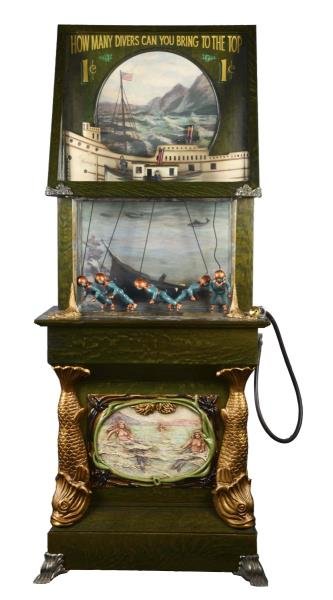


" "Divers" Mills "Hats off" Mills "Love" Spirometer
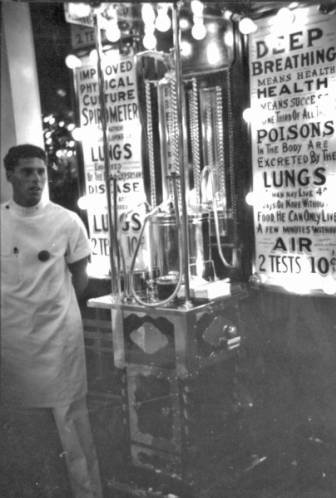
 Lung testers on site at Playland amusement Park New York late 1920's
Lung testers on site at Playland amusement Park New York late 1920's
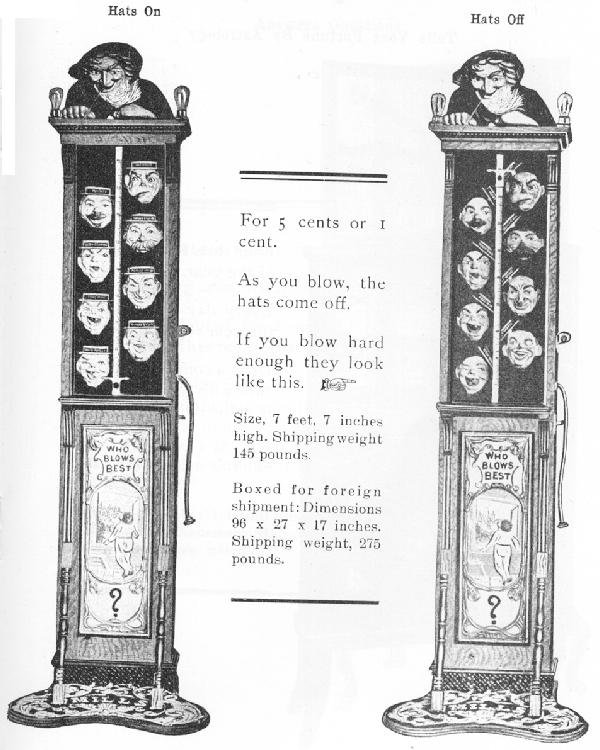
Advertising flyer for the "Hats off" Note that this machine was over 7 feet tall and weighed 145lbs
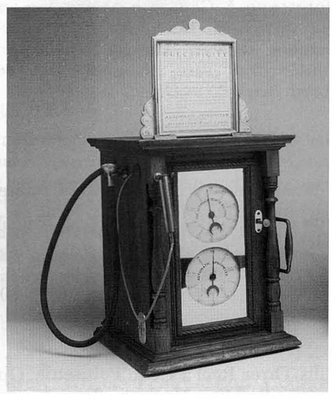
This spiro not only allowed you the chance to catch a nasty illness but gave you a surprisingly strong electric shock, but more about that other favourite of the age "electricity " later
Electricity is Life
In the late 19th Cent electricity was new to everyday life and was the latest fad, many claimed it was the answer to all the world problems from dark streets to chronic illness. The coin-operated world was quick to latch on, a machine with a light bulb was a novelty, one that gave you an electric shock was a "must play"
Shockers
In the early 1900s, electric shock treatment was all the rage in the medical profession as a cure for everything from headaches to cancer. The coin-op makers took up this idea and most produced "shockers". Some simply gave the player a simulated shock that was simply a rapid vibration but most really did give the player an electric shock, and a large one at that. Their machines used the same mechanism used by the medical profession at the time, an electric exciter.

These wound coil units were either hand-cranked or ran from a battery, often 9v, these charged up on insertion of a coin then discharged through the player via a metal handle or knob. The voltage produced was very high but the amps were low, this produced a shock strong enough to kick the player back across the room if he was not prepared, but, at least in theory, didn't cause the player any harm. On Many of these machines, the strength of the shock could be altered allowing the brave player to show off to his friends (and the ladies of course) how much of a shock he could stand. Other machines suggested that regular use was of medical benefit to the user. Others used the shock to get around gambling laws by attaching a shocker to a gaming machine and claiming the player was buying the shock not playing a gambling game. These machines stayed on the maker's lists well into the 1940's but the novelty of electricity was wearing thin, many of the gaming machines had their exciters removed, the electricity for health machines fell into disuse and the show off shocker was the only style to survive for any length of time, These machines are highly sort after and demand high prices today.
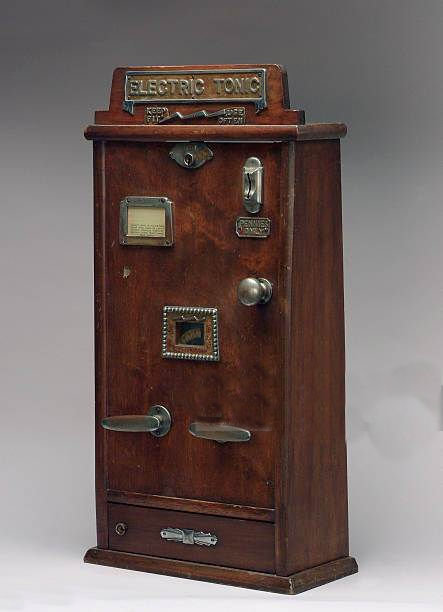



this beauty was hand cranked and shows the exciter This one appears to be battery powered


This high quality machine was made by the mills novelty Co
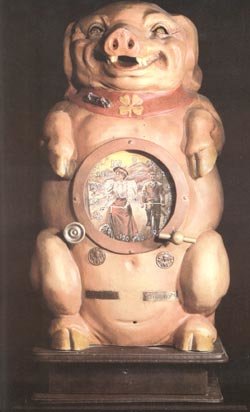
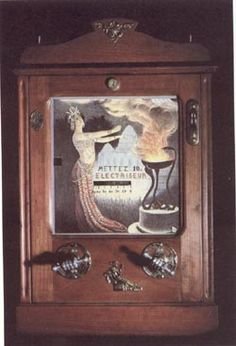
Two french Electric shockers from the late 19th cent,if you could stand the full charge from the pig his eyes lit up
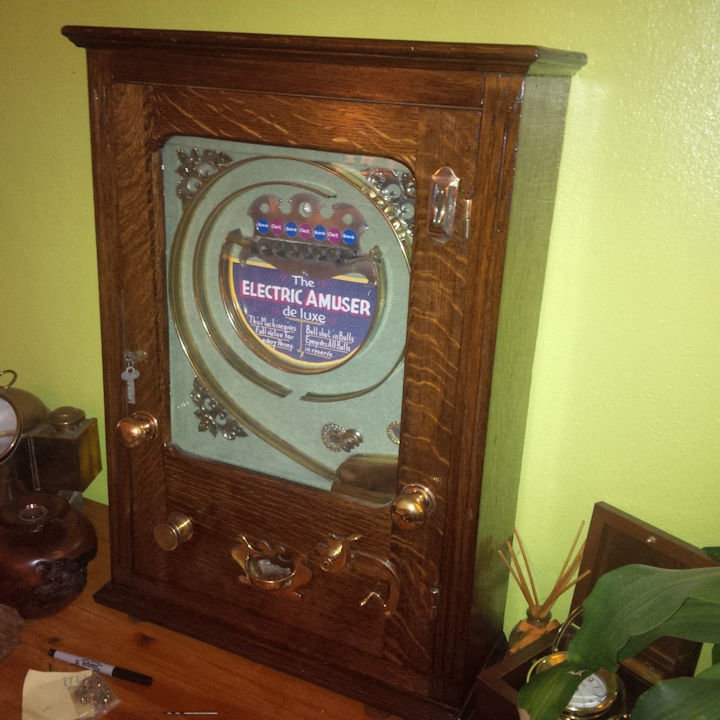
This rather fine looking machine formerly in my own collection, was an attempt to avoid gambling laws, the claim was the player bought the electric shock(quite a strong one I can personally assure you) and the allwin game was a free game of skill. A case brought to the high court in 1914 during which one of these machines was operated in court by a burly policeman proved the claim not to be the case because there was no skill in the game and the operator was fined £5

This beautifully made but slightly odd machine was made by the Watling Scale co. It didn't actually give you an electric shock just a rapid vibration through the strangely positioned "third hand" (?). It's doubtful if this machine would be allowed today in that particular configuration. A strength tester with a similar layout and made by Caille can be seen on page 2.
